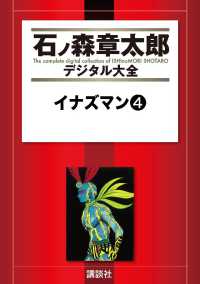- ホーム
- > 洋書
- > 英文書
- > Science / Mathematics
Full Description
This book guides readers to the new concept of "Satoumi" and explains how its practice works to solve challenges in complex social-ecological systems of coastal areas. The book describes the significance of Satoumi Science as a transdisciplinary process. It starts with introducing the definition of Satoumi, highlights the important distinction between active measures (direct actions to improve ecosystem functions and services) and passive measures (a variety of management activities), and presents the concept of Integrated Local Environmental Knowledge (ILEK) as a knowledge base for Satoumi activities. It also introduces residential researchers and bilateral knowledge translators as the key actors of Satoumi co-creation through the transdisciplinary processes.
The concept of Satoumi goes beyond the idea of protecting pristine nature by eliminating humans. It is about creating coastal environments where humans closely connect with the sea, which leads to the effective conservation and sustainable management of various natural resources and ecosystem services.
This book will be of high interest to managers, governments, environmental groups, and the research community. Chapters cover current and emerging concerns, such as over- and under-use of natural resources, restoration of damaged ecosystems, and co-creation of new relations between humans and coastal seas, from transdisciplinary approaches to tackle with complex and 'wicked' challenges of coastal social-ecological systems.
Contents
Chapter 1. Prologue: What is Satoumi?.- Chapter 2. The History and Future of Satoumi Concept.- Chapter 3.Global Effect of the Satoumi Concept - Harmony of Human Society with the Ocean Biome.- Chapter 4. Roles of Women in Satoumi .- Chapter 5. Enlivening Ecosystems with Human Hands: Building Satoumi through Coral Reef Culture.- Chapter 6. Restoring Eelgrass Beds and Culturing Oysters.- Chapter 7. Reviving Abandoned Aquaculture Ponds and Coastal Areas by Integrated Multi Tropic Aquaculture.- Chapter 8. Conserving Multiple Coral Reef Resources.- Chapter 9. Villagers Managing Lake Fisheries Resources by Themselves: Mbenji Islands in Lake Malawi.- Chapter 10. Protecting Fisheries Resources through Marine Protected Area Networks - Fiji.- Chapter 11. Connecting Local Regions and Cities through Mozuku Seaweed Farming and Coral Reef Restoration: Onna Village, Okinawa.- Chapter 12. Divers and Fishermen Working Together to Create Satoumi.- Chapter 13. Models for Implementing the Satoumi Concept via Residential Research Institute Collaborations with Citizen Scientists in the United States.- Chapter 14. Epilogue: Opening the Way to Sustainable Futures with Satoumi.
-

- 電子書籍
- GARIYA-世界に君しかいないー 1…
-

- 電子書籍
- イナズマン(4)






